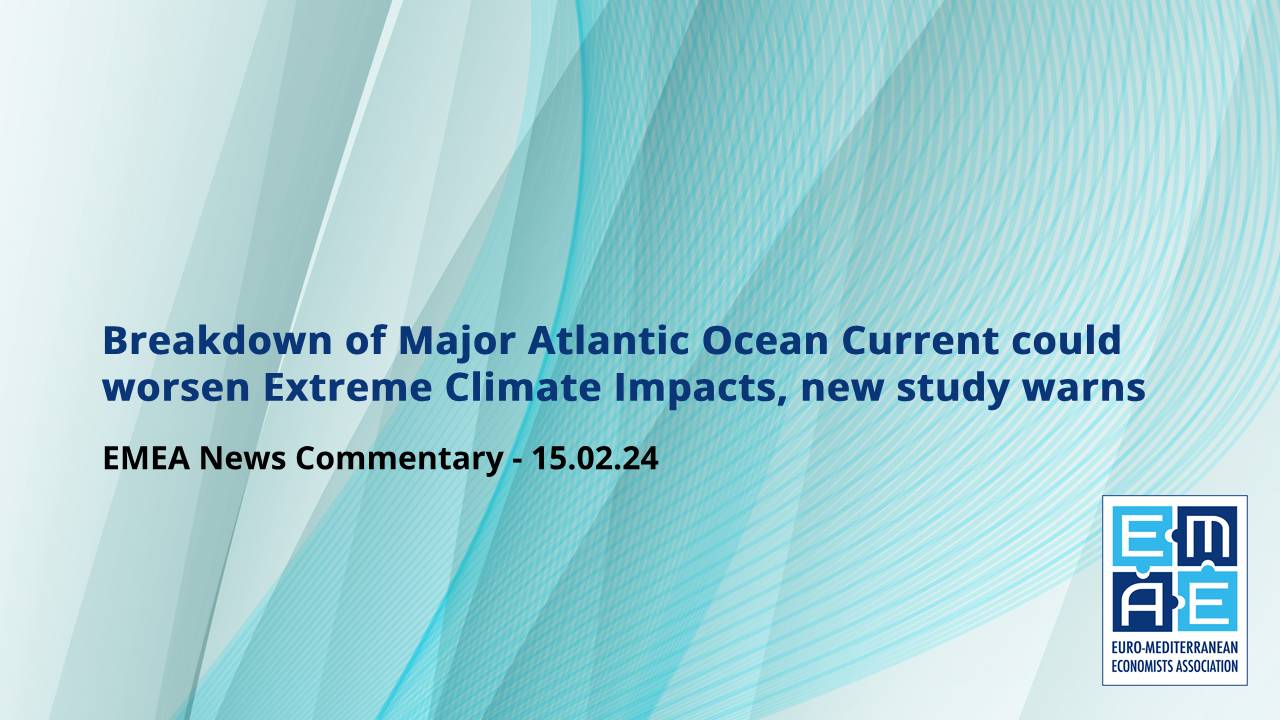The “tipping point” for a frozen Europe, scorched tropics and rising North Atlantic sea levels may be nearer than predicted, according to a shock report by the Intergovernmental Panel on Climate Change (IPCC).
These climactic events would be triggered by disruption to the critically important Atlantic Meridional Overturning Current (AMOC), responsible for moving warm and cold water between the poles.
The fear is that the current could fail, as a result of “increasing freshwater inflows from melting ice sheets and rivers swelled by global warming.”
The ensuing disturbance to the global climate would be capable of reversing dry and rainy seasons in the Amazon and altering Asian monsoon rainfall patterns, according to the report, recently published in Science Advances.
Changes in rain distribution following AMOC breakdown could also see the partial loss of other connected Atlantic Ocean currents, like the Gulf Steam, said the report’s co-author, René van Westen, a climate and physics researcher from Utrecht University
He believed this would lead to a dynamic, one metre level rise in North Atlantic Sea levels. “And you need to add that on top of the sea level rise already caused by global warming. So, the problems are really severe,” he warned, adding that the East Coast of the United States would be one of the worst hit regions by an AMOC shut down, due to warming waters collecting there – instead of flowing north to the Arctic.
Extreme inland heatwaves, more intense storms and increased rainfall are all knock-on effects of warming coastal oceans.
Collapse of heat-transporting ocean
Van Westen said a reduction in Arctic-bound warm sea could see the expansion of sea ice reaching as far south as England, with areas of Europe drying out and cooling by 1.5˚C per decade.
Peter Ditlevsen, an ice and climate researcher with the University of Copenhagen Niels Bohr Institute, who wrote a related 2023 paper in Nature Communications, warned of an AMOC tipping point by the middle of this century.
He said some of these projected impacts would be impossible to adapt to. The collapse of heat-transporting ocean circulation was something that couldn’t be adapted to. “There are some studies of what happens to agriculture in Great Britain and it becomes like trying to grow potatoes in northern Norway,” he remarked.
He reckoned that if current global warming trends continued, the planet would be between one and two degrees hotter by 2050. If the AMOC were to collapse around that time, Western Europe would cool to pre-industrial levels and experience greatly reduced rainfall.
Other parts of the world – notably the southern hemisphere and the tropics – would warm up faster, due to the failure of ocean heat reaching the northern areas of ocean.
“It’s not science fiction,” said van Westen. “We need to show this is not only a Hollywood blockbuster, ‘The Day After Tomorrow.’ This is real, this can happen. And I think it’s important and urgent to keep saying to people, okay, we need to really tackle our emissions,” he added.
The latest study – described as “a major advance in AMOC stability science” – took a detailed look at what would happen to the current’s circulatory balance if greater amounts of freshwater flowed into the Atlantic.
Increased rainfall, river run-off and melting ice would “push the AMOC past its tipping point” first suggested in 1960 climate models.
Latest research embellishes existing concerns
The latest research “crushes the hope that some feedback might prevent an AMOC collapse,” said Stefan Rahmstorf, head of earth system analysis with the Potsdam Institute for Climate Impact Research.
He’d hoped that more refined modelling would identify something that could prevent disruption to the ocean’s currents – but this hadn’t happened.
Rahmstorf continued: “The billion-dollar question is, how far away is this tipping point? Three recent studies, using different data and methods, have argued that we are approaching the tipping point and that it might be rather close, even posing a risk of crossing it in the next decades.” He did admit, however, that the reliability of these studies had been questioned.
The last AMOC breakdown took place around 12,000 years ago and was understood to have caused plummeting Greenland temperatures of up to 10 degrees within a few decades, creating glacial advance and a largely drier northern hemisphere.
According to a 2021 study, 400 billion tons water now flow into the North Atlantic every year from the melting Greenland Ice Sheet. At the same time, increasing amounts of freshwater are being discharged from Arctic-flowing rivers.
Antarctica ice also at risk
In recent decades, the AMOC may have slowed to a virtual shutdown due to “sharp reductions of atmosphere-cooling industrial aerosols, both over the Atlantic, as well as from sources in Asia and Europe.” It’s thought the stability of ice in Antarctica could also be at risk.
The article also cited two recent papers on the acceleration of global warming, one of which stated that AMOC shutdown was not unusual and occurred in the Eemian (an interglacial period around 120,000 years ago). The other study suggested that the Southern Hemisphere AMOC “may also be failing, for the same reason as in the Arctic – an increase of Antarctic meltwater…”
The latest research by van Westen’s team – described as “a physics-based and observable type of early warning signal” – was said to have been based on AMOC-transported Atlantic freshwater emanating from the latitude of the southern tip of Africa.
The study had modelled a theoretical span of around 2,200 years, beginning with pre-industrial climate conditions, gradually increasing the amount of freshwater entering the North Atlantic. This had triggered “an abrupt AMOC tipping point” at the 1,758th year of the model. From this, a real time 2050 tipping point was deduced, which could “to some degree, be an accurate projection,” according to Rahmstorf.
He said the latest study had also confirmed previous concerns that climate modelling had overestimated the stability of AMOC and that the IPCC “had so far underestimated the risk of an AMOC collapse.” Until now, the IPCC have said that there was less than a ten per cent chance of the AMOC breaking down this century.
“We will ignore this risk at our peril,” Rahmstorf warned.





